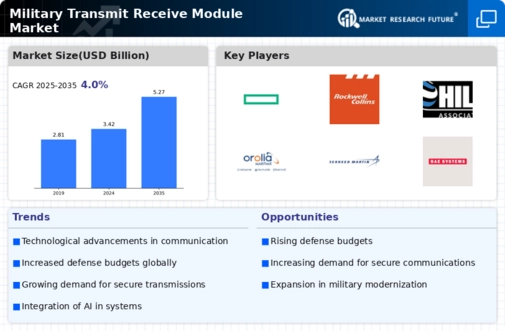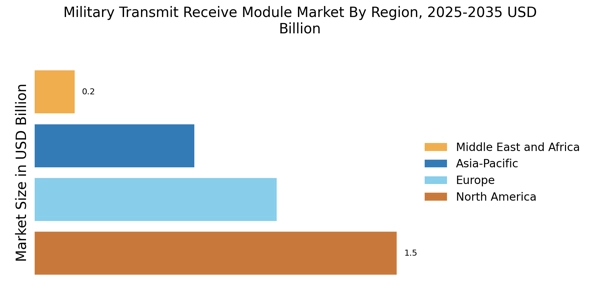Increased Defense Spending
The Military Transmit Receive Module Market is poised for growth as nations around the world increase their defense budgets. This trend is driven by geopolitical tensions and the need for enhanced military capabilities. According to recent data, defense spending has seen a notable rise, with many countries allocating significant resources to modernize their military equipment. This includes investments in advanced communication systems, where transmit-receive modules play a critical role. The emphasis on upgrading existing military infrastructure and acquiring new technologies is likely to bolster the demand for these modules. As defense budgets continue to expand, the Military Transmit Receive Module Market may witness a corresponding increase in market opportunities, particularly in regions with heightened security concerns.
Focus on Electronic Warfare Capabilities
The Military Transmit Receive Module Market is significantly influenced by the growing focus on electronic warfare capabilities. As military strategies evolve, the need for effective communication and counter-communication systems becomes paramount. Electronic warfare involves the use of electromagnetic spectrum to disrupt enemy communications while ensuring the integrity of one's own systems. This necessitates advanced transmit-receive modules that can operate effectively in contested environments. The increasing investment in electronic warfare technologies indicates a strong demand for sophisticated communication modules that can withstand electronic attacks. Consequently, the Military Transmit Receive Module Market is likely to benefit from this trend, as military forces seek to enhance their operational effectiveness in electronic warfare scenarios.
Emerging Markets and Defense Collaborations
The Military Transmit Receive Module Market is also being shaped by emerging markets and international defense collaborations. Countries with developing defense sectors are increasingly investing in advanced communication technologies to modernize their military capabilities. Collaborative defense initiatives among nations are fostering the exchange of technology and expertise, which is beneficial for the Military Transmit Receive Module Market. These collaborations often lead to joint ventures and partnerships that enhance the development and deployment of advanced transmit-receive modules. As emerging markets continue to grow and seek to enhance their military readiness, the demand for sophisticated communication systems is likely to increase, presenting new opportunities for the Military Transmit Receive Module Market.
Integration of Multi-Channel Communication Systems
The Military Transmit Receive Module Market is witnessing a shift towards the integration of multi-channel communication systems. These systems allow for simultaneous transmission and reception of multiple signals, enhancing operational efficiency and flexibility. As military operations become more complex, the ability to manage various communication channels is crucial. This trend is driven by the need for interoperability among different military branches and allied forces. The demand for multi-channel transmit-receive modules is expected to rise as militaries seek to streamline their communication processes. Furthermore, the integration of these systems into existing military platforms could potentially lead to increased market growth for the Military Transmit Receive Module Market, as they offer enhanced capabilities and improved situational awareness.
Technological Advancements in Communication Systems
The Military Transmit Receive Module Market is experiencing a surge due to rapid technological advancements in communication systems. Innovations such as software-defined radios and advanced signal processing techniques are enhancing the capabilities of transmit-receive modules. These advancements allow for improved data transmission rates, greater reliability, and enhanced security features. As military operations increasingly rely on real-time data and communication, the demand for sophisticated transmit-receive modules is expected to rise. The integration of artificial intelligence and machine learning into these systems further enhances their operational efficiency, suggesting a robust growth trajectory for the Military Transmit Receive Module Market. Furthermore, the increasing complexity of military operations necessitates the adoption of advanced communication technologies, which could potentially drive market expansion.


















Leave a Comment